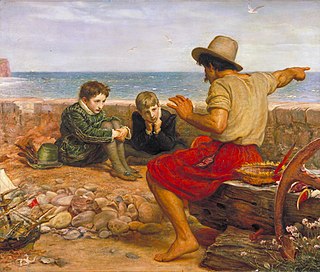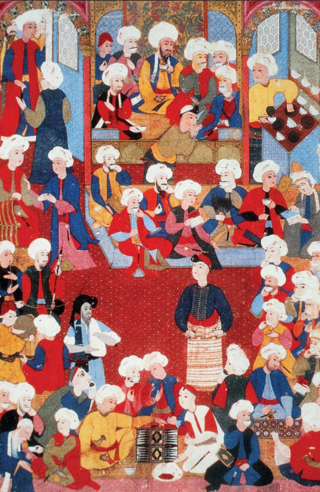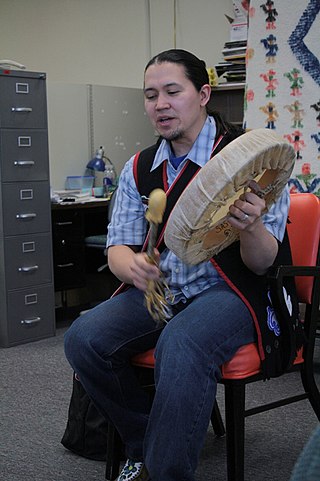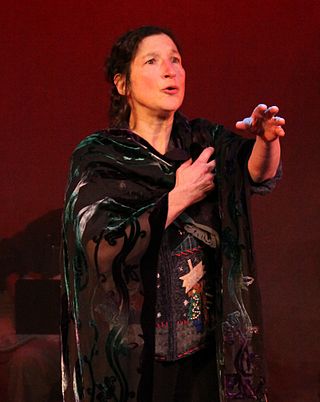
Storytelling is the social and cultural activity of sharing stories, sometimes with improvisation, theatrics or embellishment. Every culture has its own stories or narratives, which are shared as a means of entertainment, education, cultural preservation or instilling moral values. Crucial elements of stories and storytelling include plot, characters and narrative point of view. The term "storytelling" can refer specifically to oral storytelling but also broadly to techniques used in other media to unfold or disclose the narrative of a story.

A narrative, story, or tale is any account of a series of related events or experiences, whether nonfictional or fictional. Narratives can be presented through a sequence of written or spoken words, through still or moving images, or through any combination of these. The word derives from the Latin verb narrare, which is derived from the adjective gnarus. The formal and literary process of constructing a narrative—narration—is one of the four traditional rhetorical modes of discourse, along with argumentation, description, and exposition. This is a somewhat distinct usage from narration in the narrower sense of a commentary used to convey a story. Many additional narrative techniques, particularly literary ones, are used to build and enhance any given story.
Hugh Lupton is a British storyteller, one of the most prominent figures in the tradition of oral storytelling.

Meddah is the name given to a traditional Turkish story teller, who played in front of a small group of viewers, such as a coffeehouse audience. This form of performance was especially popular in the Ottoman Empire from the 16th century onwards. The play was generally about a single topic, the meddah playing different characters, and was usually introduced by drawing attention to the moral contained in the story. The meddah would use props such as an umbrella, a handkerchief, or different headwear, to signal a change of character, and was skilled at manipulating his voice and imitating different dialects. There was no time limitation on the shows; a good meddah had the skill to adjust the story depending on interaction with the audience.
Edmund Lenihan, also known as Eddie Lenihan, is an Irish author, storyteller, lecturer and broadcaster. He is one of the few practising seanchaithe remaining in Ireland. He has been called "one of the greatest of Irish story-tellers", "a national treasure"and an "absolute legend."
Iranian folklore encompasses the folk traditions that have evolved in Greater Iran.

Lynette (Lyn) Ford, an American storyteller, teaching artist, author and creative narrative workshop presenter was the first storyteller in the state of Ohio to be nominated for a Governor's Award for the Arts. She is a regular performer at regional and national storytelling festivals and conferences, including the National Storytelling Festival, Hawaii's Talk Story Festival and the Timpanogos Storytelling Festival. Lyn has also shared keynote presentations, performances and workshops in Australia and Ireland, and for the Transformative Language Arts Network's and Ohio Literacy Resource Center's annual conferences and events.
The Timpanogos Storytelling Festival takes place Labor Day weekend at the end of each summer in Lehi, Utah. The festival draws a combined attendance of about 26,000 people each year, making it one of the largest storytelling festival in the United States. The festival typically lasts two days and invites professional storytellers from throughout the United States. In addition to daytime performances on Friday and Saturday, there are typically themed public performances in the evenings, such as Look Who's Talking, Bedtime Stories, My Favorite Stories, and Laughing' Night.
Fran Stallings is an American storyteller for people of all ages. She has performed at numerous national and international storytelling festivals, in schools and libraries, and on the radio. She performs primarily folktales from around the world. She has authored several audio recordings and books of stories and songs.
Australia traditional storytelling, handed down from generation to generation, has always been part of the landscape. Since the beginning of time storytelling played a vital role in Australian Aboriginal culture, one of the world's oldest cultures. Aboriginal children were told stories from a very early age; stories that helped them understand the air, the land, the universe, their people, their culture, and their history. Elders told stories of their journeys and their accomplishments. As the children grew into adults they took on the responsibility of passing on the stories. These stories are as much a cultural necessity as they are entertainment and are still passed on orally though many are now recorded in print, audio and video

Storyteller is a collection of works, including photographs, poetry, and short stories by Leslie Marmon Silko. It is her second published book, following Ceremony. The work is a combination of stories and poetry inspired by traditional Laguna Pueblo storytelling. Silko's writings in Storyteller are influenced by her upbringing in Laguna, New Mexico, where she was surrounded by traditional Laguna Pueblo values but was also educated in a Euro-American system. Her education began with kindergarten at a Bureau of Indian Affairs school called the Laguna Day School "where the speaking of the Laguna language was punished."
American Sign Language literature is one of the most important shared cultural experiences in the American deaf community. Literary genres initially developed in residential Deaf institutes, such as American School for the Deaf in Hartford, Connecticut, which is where American Sign Language developed as a language in the early 19th century. There are many genres of ASL literature, such as narratives of personal experience, poetry, cinematographic stories, folktales, translated works, original fiction and stories with handshape constraints. Authors of ASL literature use their body as the text of their work, which is visually read and comprehended by their audience viewers. In the early development of ASL literary genres, the works were generally not analyzed as written texts are, but the increased dissemination of ASL literature on video has led to greater analysis of these genres.

Alaska Native storytelling has been passed down through generations by means of oral presentation. The stories tell life lessons or serve as lessons in heritage. Many different aspects of Arctic life are incorporated into each story, mainly the various animals found in Alaska. Due to the decline in the number of speakers of native languages in Alaska and a change in lifestyle amongst many of the native peoples, oral storytelling has become less common. In recent years many of these stories have been written down, though many people argue that the telling of the story is just as important as the words within.

Judith Black is an American professional storyteller, who has toured internationally, telling stories to a wide ranging audience in the United States, Europe, and the Near East. She has produced thirteen CDs, and won a variety of awards, such as the coveted Oracle Award. Her work has been featured in venues such as the Smithsonian Institution and the Montreal Comedy Festival, and has been featured seven times at the National Storytelling Festival. In addition she has produced a variety of seminars and workshops for storytellers. She has been commissioned by the U.S. Department of the Interior, National Public Radio, religious institutions, and non-profit organisations to create original stories that strengthen their respective missions.
Personal narrative (PN) is a prose narrative relating personal experience usually told in first person; its content is nontraditional. "Personal" refers to a story from one's life or experiences. "Nontraditional" refers to literature that does not fit the typical criteria of a narrative.
Margaret Read MacDonald is an American storyteller, folklorist, and award-winning children's book author. She has published more than 65 books, of stories and about storytelling, which have been translated into many languages. She has performed internationally as a storyteller, is considered a "master storyteller", and has been dubbed a "grand dame of storytelling". She focuses on creating "tellable" folktale renditions, which enable readers to share folktales with children easily. MacDonald has been a member of the board of the National Storytelling Network and president of the Children's Folklore Section of the American Folklore Society.

Pleasant DeSpain is an international storyteller, world traveler, and author of multicultural story collections and picture books, many of which are used in elementary schools and libraries as multicultural teaching aids. He has performed in more than 3,000 schools, theaters, conventions, libraries, and churches in America, Canada, Mexico, Thailand, Southeast Asia, and Central America.
Indigenous cultures in North America engage in storytelling about morality, origin, and education as a form of cultural maintenance, expression, and activism. Falling under the banner of oral tradition, it can take many different forms that serve to teach, remember, and engage Indigenous history and culture. Since the dawn of human history, oral stories have been used to understand the reasons behind human existence. Today, Indigenous storytelling is part of the broader indigenous process of building and transmitting indigenous knowledge.
Kung Jaadee is a traditional Haida storyteller, singer, drummer, teacher, and children's book author from the village of Old Massett, Haida Gwaii in Northern British Columbia, Canada.
Linda Goss, sometimes known professionally as Mama Linda, is an American storyteller and performer in the African diasporic oral tradition. She is a co-founder of the National Association of Black Storytellers, which works to preserve folk traditions.










